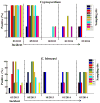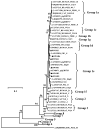Occurrence, source, and human infection potential of Cryptosporidium and Enterocytozoon bieneusi in drinking source water in Shanghai, China, during a pig carcass disposal incident
- PMID: 25383482
- PMCID: PMC5788171
- DOI: 10.1021/es504464t
Occurrence, source, and human infection potential of Cryptosporidium and Enterocytozoon bieneusi in drinking source water in Shanghai, China, during a pig carcass disposal incident
Abstract
In March 2013, thousands of domestic pig carcasses were found floating in the Huangpu River, a drinking source water in Shanghai, China. To investigate the impact of the pig carcass incident on microbial water quality, 178 river water samples were collected from the upper Huangpu River from March 2013 to March 2014. Samples were concentrated by calcium carbonate flocculation and examined for host-adapted Cryptosporidium and Enterocytozoon bieneusi by ploymerase chain reaction (PCR). Positive PCR products were sequenced to determine Cryptosporidium species and E. bieneusi genotypes. A total of 67 (37.6%) and 56 (31.5%) samples were PCR-positive for Cryptosporidium and E. bieneusi, respectively. The occurrence rates of Cryptosporidium and E. bieneusi in March 2013 (83.3%; 41.7%) and May 2013 (73.5%; 44.1%) were significantly higher than rates in later sampling times. Among the 13 Cryptosporidium species/genotypes identified, C. andersoni and C. suis were the most common species, being found in 38 and 27 samples, respectively. Seventeen E. bieneusi genotypes were found, belonging to 11 established genotypes (EbpC, EbpA, D, CS-8, PtEb IX, Peru 8, Peru 11, PigEBITS4, EbpB, G, O) and six new ones (RWSH1 to RWSH6), most of which belonged to pig-adapted Groups 1d and 1e. EbpC was the most common genotype, being found in 37 samples. The distribution of Cryptosporidium species and E. bieneusi genotypes suggest that dead pigs contributed significantly to Cryptosporidium and E. bieneusi contamination in the Huangpu River. Although most Cryptosporidium species found in river water were not major human pathogens, the majority of E. bieneusi genotypes detected were endemic in China. Data from this study should be useful in the development of strategies in addressing future contamination events in drinking water supplies.
Conflict of interest statement
The findings and conclusions in this report are those of the authors and do not necessarily represent the views of the Centers for Disease Control and Prevention.
The authors declare no competing financial interest.
Figures



References
-
- Xiao L. Molecular epidemiology of cryptosporidiosis: an update. Exp Parasitol. 2010;124(1):80–9. - PubMed
-
- Coupe S, Delabre K, Pouillot R, Houdart S, Santillana-Hayat M, Derouin F. Detection of Cryptosporidium, Giardia and Enterocytozoon bieneusi in surface water, including recreational areas: a one-year prospective study. FEMS Immunol Med Microbiol. 2006;47(3):351–9. - PubMed
-
- Izquierdo F, Castro Hermida JA, Fenoy S, Mezo M, Gonzalez-Warleta M, del Aguila C. Detection of microsporidia in drinking water, wastewater and recreational rivers. Water Res. 2011;45(16):4837–43. - PubMed
-
- Jellison KL, Lynch AE, Ziemann JM. Source tracking identifies deer and geese as vectors of human-infectious Cryptosporidium genotypes in an urban/suburban watershed. Environ Sci Technol. 2009;43(12):4267–4272. - PubMed
Publication types
MeSH terms
Substances
Associated data
- Actions
- Actions
- Actions
- Actions
- Actions
- Actions
Grants and funding
LinkOut - more resources
Full Text Sources
Other Literature Sources
Medical

